September 22, 2021 report
Astronomers detect a chromospherically active eclipsing binary system

Astronomers from the Ohio State University (OSU) and elsewhere report the discovery of a new peculiar binary as part of the All-Sky Automated Survey for SuperNovae (ASAS-SN). The newfound system, which received designation ASASSN-V J192114.84+624950.8, turns out to be a chromospherically active eclipsing binary system with a highly eccentric orbit. The finding is detailed in a paper published September 15 on arXiv.org.
Although ASAS-SN is designed to search for supernovae and bright transient events, it also monitors the brightness of about 100 million stars, which can lead to the identification of new variables. However, one class of variable stars is often missed by automated light curve searches like ASAS-SN—eclipsing binaries.
Now, a team of astronomers led by OSU's Zachary S. Way reports the finding of such an eclipsing binary system from ASAS-SN. The group detected the variability of the stellar source ASASSN-V J192114.84+624950.8 (or J1921 for short), and by conducting photometric observations with NASA's Transiting Exoplanet Survey Satellite (TESS), they found that this source is a highly eccentric, eclipsing binary with rotational variation.
"As part of an All-Sky Automated Survey for SuperNovae search for sources with large flux decrements, we discovered a transient where the quiescent, stellar source, ASASSN-V J192114.84+624950.8, rapidly decreased in flux by ∼ 55% (∼ 0.9 mag) in the g-band. The TESS light curve revealed that the source is a highly eccentric, eclipsing binary," the researchers wrote in the paper.
The study found that J1921 is a binary consisting of two chromospherically active, rotational variable stars in an eclipsing and highly eccentric (with an eccentricity of about 0.79), 18.46-day orbit. The eclipses span only about two percent of the total phase. The system is located 1,027 light years away from the Earth.
According to the paper, the primary star of J1921 (assumed to be a late-G or early-K type dwarf) has a radius of about 0.9 solar radii and is some 29 percent less massive than the sun. It has a luminosity at a level of around 0.48 solar luminosities and its effective temperature is estimated to be 5,050 K. The star's rotational period was measured to be approximately 1.52 days.
The secondary star has a radius of some 0.64 solar radii, while its mass is estimated to be 0.55 solar masses. The luminosity of this star is only 0.12 solar luminosities and its effective temperature was calculated to be about 4,190 K. It takes this object approximately 1.79 days to rotate around its axis.
In concluding remarks, the astronomers write that the peculiar properties of J1921 make it a very interesting target for future studies focused on testing theoretical models. "This system, due to its proximity and peculiar orbit, may be interesting for the outstanding discrepancy between theoretically predicted and actual radii of late type stars," the researchers explained.
More information: Zachary S. Way et al, Discovery of a Highly Eccentric, Chromospherically Active Binary: ASASSN-V J192114.84+624950.8. arXiv:2109.07586v1 [astro-ph.SR], arxiv.org/abs/2109.07586
© 2021 Science X Network




















